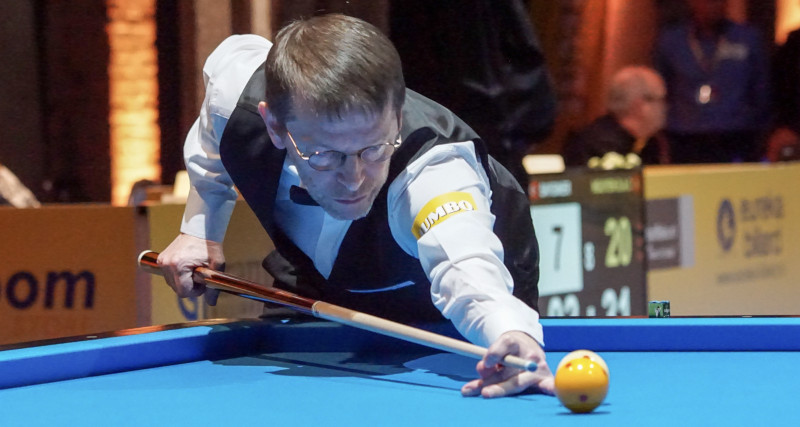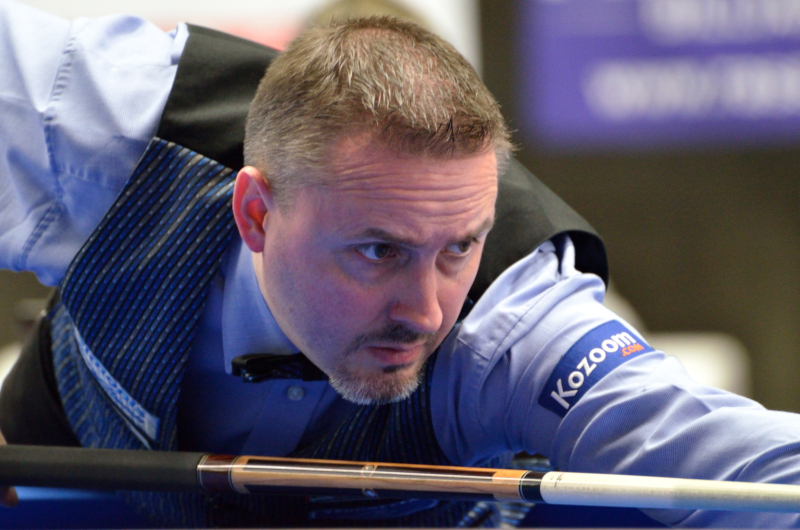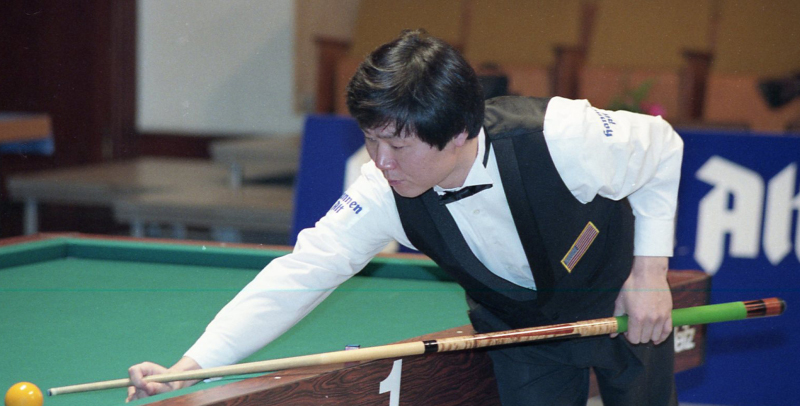Opinion/Blog

- Written by: Sal Bello
- Hits: 442
Step into any billiards hall and you’ll notice something interesting: not every match is won by the most technically skilled player. More often, it’s the calm, composed, and quietly confident individual who takes control of the game. This isn’t a coincidence. In billiards—whether it’s three-cushion, English pool, or snooker—your mindset can be just as important as your shot.
In this article, we'll delve into the psychological side of billiards, explore common mistakes players make in their mental game, and how to develop a stronger mindset to help you perform at your best in crucial moments.
Why Billiards Is as Much Mental as Physical
On the surface, 3-cushion billiards appears to be a game of geometry, angles, and spin. But once you spend enough time at the table, you’ll realize another opponent is lurking in the shadows: pressure. The pressure of a simple game of billiards should be normal. And a single mistake can cost you the nerves of an entire set. Deep down, a voice whispers, "Don't miss this one!"
This inner dialogue shapes every shot you make. If your mindset isn't stable, even the best cue in the world can't save you. As the saying goes, "The table doesn't lie—it simply reflects the player's mindset."
Common Mental Mistakes Players Make
Just as technical errors need to be avoided, there are also mental pitfalls that can quietly sabotage your performance. Here are some of the biggest ones:
1. Overthinking the Simple Shots
Ironically, it’s often the “easy” billiards that get missed. Why? Because players start over-analyzing, worrying about the outcome instead of trusting their training. It’s classic paralysis by analysis.
How to avoid: Simplify your thought process. See the path, trust your stroke, and let it flow. The practice you’ve put in is already in your muscle memory—rely on it.
2. Letting One Mistake Spiral
We’ve all been there: you miss an easy chance, frustration sets in, and before you know it, two or three frames have slipped away. It’s like dominoes toppling—one mistake can lead to others.
How to avoid: Learn the art of the reset. Take a deep breath, chalk your snooker cue, and treat the next shot as if it’s the first of the match. Short memory, sharp focus.
3. Playing Your Opponent, Not the Table
In competitive matches, it’s tempting to get caught up in what your opponent is doing—whether they’re stringing together runs or trying to rattle your confidence. But losing focus on the table is a recipe for errors.
How to avoid this: Remember, 3-cushion is ultimately about solving the puzzle in front of you. Your opponent is just a bystander when it’s your turn. Keep your eyes, and your mind, on the angles and the cushions.
4. Chasing Perfection
Some players set excessive standards for themselves, expecting every shot to be flawless. When reality inevitably falls short, their confidence crumbles.
How to avoid this: Accept that mistakes are part of the game. Even great players make mistakes. The difference is, they don’t let it define their match. Aim for progress, not perfection.
Building a Winning Mindset
So, what separates a mentally strong 3-cushion player from the rest? It often comes down to habits—little routines that reinforce confidence and calmness. Here are a few to try:
- Pre-match Visualization Practice
Many top players “play the match in their minds” before they strike the first ball. Visualizing smooth strokes, precise cue ball paths, and calm execution primes the brain for success.
- A Pre-Shot Routine
Perseverance fosters confidence. A small ritual—whether it's chalking your pool cue, adjusting your stance, or taking a deep breath—signals to your brain that you're ready. It can distance you from nerves and make stressful situations seem familiar.
- Positive Self-Talk
It might sound cheesy, but words matter. Replacing “Don’t miss” with “Slow and steady” can help your focus away from fear and towards action. Talk to yourself like a coach, not a critic.
- Embracing Pressure
Rather than viewing pressure as a threat, consider it as a privilege. After all, pressure only exists when something meaningful is on the line. It means you're in the game, competing for something worth winning.
Why This Matters Beyond the Table
One of the most rewarding aspects of 3-cushion billiards is that its lessons reach far beyond the carom table. Managing nerves, bouncing back from mistakes, and keeping calm under pressure are life skills as much as game skills. Whether it’s a presentation at work, a difficult decision, or daily stress, the same mindset tools apply.
At its heart, 3-cushion isn’t just about strokes and cushions—it’s about discipline, resilience, and mental clarity. The right mindset won’t guarantee you every point, but the wrong one almost always guarantees defeat.
The next time you step up to the table, remember this: your cue delivers the stroke, but your mind directs the hand. Master both, and not only will you win more matches—you’ll also enjoy the game at a deeper level.
So when the pressure creeps in, pause and remind yourself: you’re not just playing billiards, you’re competing against yourself. And that’s the most important game of all.
- Written by: Sal Bello
- Hits: 10444
Three-cushion billiards is one of the most captivating and challenging cue sports on the planet. The game demands players to have exceptional skill, strike the ball with laser-like precision, and be highly strategic thinkers. This combination has helped three-cushion billiards mesmerize enthusiasts on a global scale.
Throughout three-cushion billiards' history, players have risen to the top, written their names in the game's history books, and left their mark on this highly skilled cue sport. This article explores five of the best three-cushion billiards players of all time. How many do you agree with?
Raymond Ceulemans (Belgium)
Many consider Belgium's Raymond Ceulemans the greatest three-cushion billiards player in history, and his remarkable trophy haul shows why. Although Ceulemans played when online sportsbook reviews sites were decades away, he was always a favorite to win whenever he entered any major billiards competition.

Ceulemans started playing billiards at the age of seven and, at 23, won his first three-cushion title in 1961. By the time the Belgian called time on his professional playing career, he had won 21 UMB three-cushion World Championships, 23 European titles, and 61 national titles! Amazingly, Ceulemans won his last UMB world title in 2001 at the age of 64!
His achievements at the billiards table did not go unnoticed back home. Ceulemans was awarded the Belgian Sports Merit Award in 1966, was crowned Belgian Sportsman of the Year in 1967, and was among the first non-Americans inducted into the Billiard Congress of America's Hall of Fame in 2001.
Torbjörn Blomdahl (Sweden)
Torbjörn Blomdahl is one of the legendary figures in modern billiards, partly because he became a three-cushion World Champion seven times, winning in 1987, 1988, 1991, 1992, 1997, 2015, and 2019. Those seven world titles rank Blomdahl second behind Ceulemans mentioned above.

He is the only Swede to become a world champion and can count eight CEB European three-cushion titles and 18 Swedish titles in addition to his seven world championship medals.
Blomdahl is renowned for his impressive runs and high averages and for taking on shots that other players would not even dream of trying. His record-highest run stands at an almost unbelievable 26, and he once made 50 points in nine innings for a 5.555 average.
Unsurprisingly, Blomdahl's talents are not confined to the three-cushion game. The Swede also excels in eight ball, nine ball, and once ran 100 in straight pool. Blomdahl is at home with a cue in his hand.
Frederic Caudron (Belgium)
Belgium's Frederic Caudron is a three-cushion billiards player famous for his high averages and exceptional runs, making him one of the sport's most formidable players. Caudron is a strategic thinker capable of thinking several moves ahead, which enables him to outmaneuver his opponents.

Caudron has won the UMB World Three-Cushion Championship twice, back-to-back Sang Lee International Opens in 2006 and 2007, the CEB European Championship twice, and an impressive 53 Belgian national titles.
Caudron's best game average of 40 points in six innings (6.666) is nothing short of amazing, and he boasts of a highest three-cushion run of 28, which he set in April 2015. At the 2017 World Championship for National Teams, played in the Scotch Double format, Caudron and Roland Forthomme made a high run of 20, which remains a record in the format today.
Dick Jaspers (Netherlands)
Dick Jaspers is one of the most successful Dutch players in three-cushion billiards history. Jaspers started playing billiards at three in the pub his parents ran in his hometown in Sint Willebrord, Netherlands.

After excelling at youth level, Jaspers made the leap to professional billiards in 1986, age 21, after watching a televised clash between Nobuaki Kobayashi and Raymond Ceulemans in the World Cup final.
Since turning professional, Jaspers has won the Three-Cushion World Cup five times and the UMB World Three-Cushion Championship three times, among many others. He is also a world record holder regarding consecutive points. He scored 34 consecutive points in the 2008 European Championship Final against Torbjorn Blomdahl, averaging 5.625.
Sang Lee (South Korea / USA)
Sang Lee was born in South Korea in 1954 but became a neutralized American citizen after moving to the United States in 1987, aged 33. Lee had already won eight Jorean titles before emigrating to America, and he dreamed of making billiards popular in the USA.

Lee earned the nickname "Michael Jordan of three-cushion billiards" after dominating the American scene, including 12 consecutive USBA National Three-Cushion Championships between 1990 and 2001. His incredible run in the USBA National Three-Cushion Championship ended in 2002 at the hands of Pedro Piedrabuena, a player Lee had trained; the apprentice became the master.
Lee won his only world title in Gent in 1993, and six years later, Billiards Digest ranked him as the fifth Greatest Living Player of the Century.
Sadly, Lee died in 2004 after battling stomach cancer. The Sang Lee International Open tournament was set up in his memory, while the BCA Hall of Fame posthumously inducted Lee in 2007.
Conclusion
The three-cushion billiards world has been shaped by many extraordinary talents over the years, but the five stars featured in this article stand out from the crowd. Nobody in the game's history can boast a trophy count near that of Raymond Ceulemans, arguably the greatest ever three-cushion billiards player.
That said, you cannot discount the incredibly talented Swede Torbjorn Blomdahl, Frederic Caudron, the record-breaking Dick Jaspers, or the late Sang Lee. Had Lee showcased his skills on the European and World stage more before his death, there is every chance he would be even more highly regarded than he is.
Each of the five players you have read about in this article has stamped their name in three-cushion billiards history books. Their enduring legacies continue influencing the game, with up-and-coming players emulating this quintet of heroes' cue action and thought processes, ensuring the sport remains as exciting and captivating as ever.
